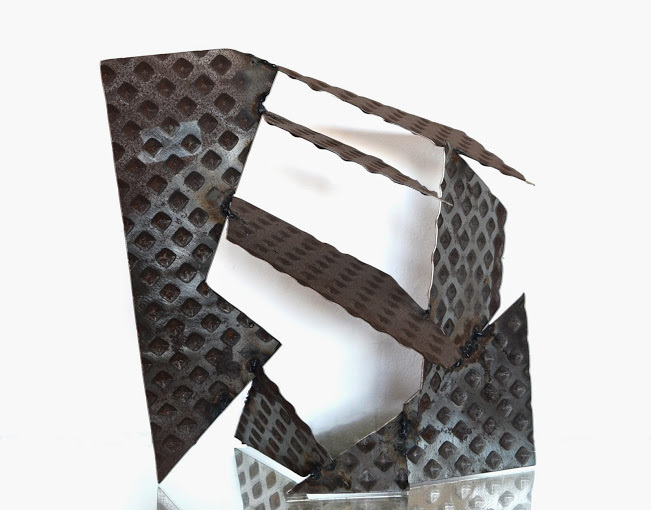The Last Supper
La Hormigonera, Barcelona
April 2014
|
An exhibition of 13 sculptures and 39 paintings.
‘The Last Supper’ is the title of the latest work in the series “Abstract Heads”. It is based on a sculpture/painting which Jonathan found on the streets of Gracia in Barcelona. He was intrigued by this object, as it gave him the opportunity to create work with a spiritual theme, while keeping within the constraints of his self-imposed rules. Modernism, as a rule, prefers to remove the spiritual, and references to God, which have been a theme in art for the longest time. Abstract Heads is a structured series of works which follow three fundamental principles in their creation: 1. The Head must be inspired from a living person, and drawn from life. 2. The size is a format of 40 x40cm. 3. The work is created as a triptych. Over time, these rules have been broken in some ways to find different ways of presenting new work. It is evident that the making of these pieces had inspiration from a model and not a series of people, however due to the nature and representation of this Last Supper, the artist could capture the essence of each one of the faces of the characters. For this exhibition the artist chose to work with both metal based sculptures and acrylic paint and ink.
What is achieved with this exhibition is to revolutionize these principles, seeking new ways to create new pieces while maintaining the essence. Based on Christian and Jewish traditions, the artist decided to conduct a supper, a tasting of appetizers representing not only Passover and The Last Supper, but joyful celebration as well. 7 types of canapés with a meaning behind their creation will be served: 1. Romaine cups, carrot & fennel slaw, toasted almonds, horseradish dressing - symbolizing the bitterness and harshness of the slavery which the Jews endured in Ancient Egypt (maror and chazeret) 2. Herb salad, capers, orange, parmesan - the salty taste symbolise the tears of the Jews in slavery (Karpas) 3. Devilled eggs - symbolizing the festival sacrifice that was offered in the Temple in Jerusalem (Beitzah) Traditionally a hard-boiled egg, the bedevilment adds a Christian element, showing that the Devil entered Judas 4. Jerusalem Artichoke crisps w/ rosemary salt - substituting the the Passover sacrifice, which was a lamb offered in the Temple in Jerusalem (Zeroa) 5. Puré de escalivada, pan de pita, crudités - representing the dish which Jesus dipped his bread into at the same time as Judas, who was prophesied to betray Jesus. 6. Apricot-saffron-pecan on matzoh with cured manchego - A sweet, brown, pebbly paste of fruits and nuts, representing the mortar used by the Jewish slaves to build the storehouses of Egypt. (Charoset) 7. Strawberry Cheesecake - a merry end to the supper, to celebrate and rejoice. Wine and cava will also be served as an essential part of the happening. |
Una exposición de 13 esculturas y 39 pinturas.
'La Última Cena' es el título del último trabajo de la serie "Cabezas Abstractas", basada en una escultura/pintura encontrada por Jonathan en las calles de Gracia. Le intrigaba este objeto, como le dio la oportunidad de crear una obra con un tema espiritual, manteniendo dentro de las limitaciones de sus reglas autoimpuestas. Modernismo, como regla general, prefiere deshacerse de lo espiritual y referencias a Dios, que han sido un tema en el arte durante mucho tiempo. Cabezas Abstractas es una serie estructurada de obras que sigue tres principios fundamentales en su elaboración: 1.Inspiración en vivo, lo que es la cabeza. 2.Se presenta en un formato de 40 x 40 cm. 3.El trabajo se presenta en forma de tríptico. Al paso del tiempo, estos principios de alguna manera han sido corrompidos para así obtener de diferentes maneras. Es evidente que para llegar a la elaboración de estas piezas, tuvimos como inspiración una figura y no una serie de personas, sin embargo debido a el acabado y representación tan exacta de La última cena, el artista pudo plasmar de forma precisa la esencia de cada uno de los rostros de los personajes que conformaron dicho evento. Para esta exposición el artista decidió trabajar tanto con esculturas a base de metales como pinturas a base de acrílico y tinta.
Lo que logramos con esta exposición, es revolucionar estos principios, buscando nuevos caminos para crear nuevas piezas pero manteniendo la esencia. A base de tradiciones judías y cristianas, el artista decidió llevar a cabo una cata de canapés representando algunos de los platillos más característicos de esta religión. Se servirán 7 tipos de canapés con un significado detrás de su elaboración: 1. Copas de lechuga romana, ensalada de zanahoria e hinojo, almendras tostadas, aliño de rábano picante - para simbolizar el amargor y la dureza de esclavitud que padecieron los Judíos en antiguo Egipto. (Maror & Chazeret) 2. Ensalada de hierbas, alcaparras, naranja, parmesano - los sabores salados simbolizan las lágrimas de los Judíos esclavizados. (Karpas) 3. Huevos rellenos (devilled eggs) - simbolizan el sacrificio del festival que se ofreció en el templo de Jerusalén (Beitzah) 4. Chips de topinambur con sal de romero - un sustituto para el sacrificio de Pesáj que era un cordero que se ofreció en el templo de Jerusalén (Zeroa) 5. Puré de escalivada, pan de pita, crudités - que representa el plato en el cual Jesus mojó el pan al mismo tiempo que Judas, quien fue profetizado a traicionar a Jesus. 6. Albaricoque, azafrán, nuez de pacano en matzá con manchego curado - Una pasta dulce y de color marrón que representa el mortero que usaron los judíos cuando construyeron los almacenes de Egipto. (Charoset) 7. Cheesecake de fresas - un fin alegre, para celebrar y regocijarse. |


